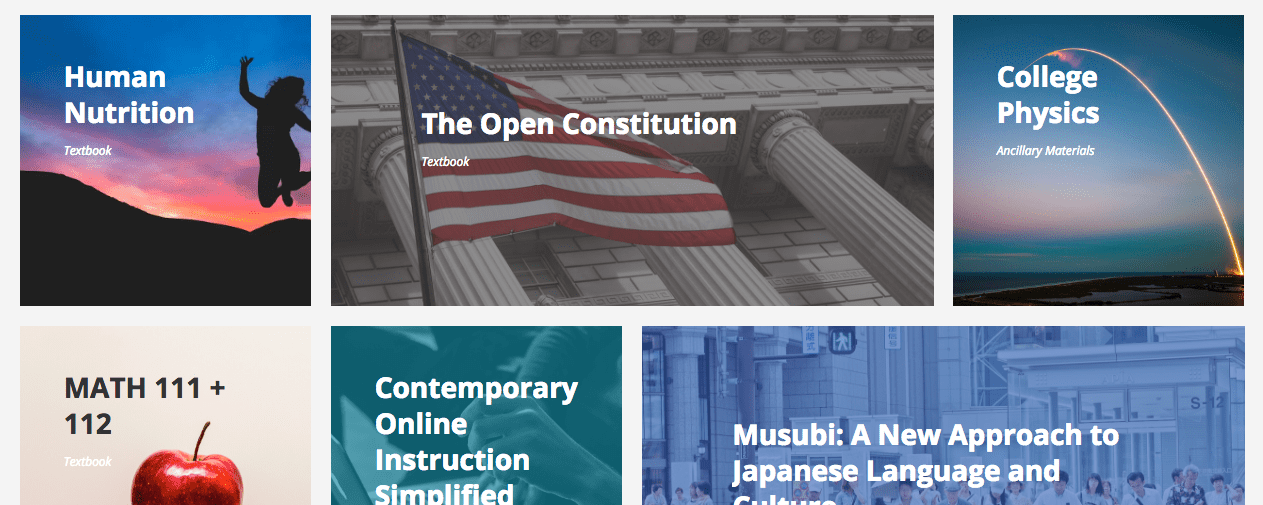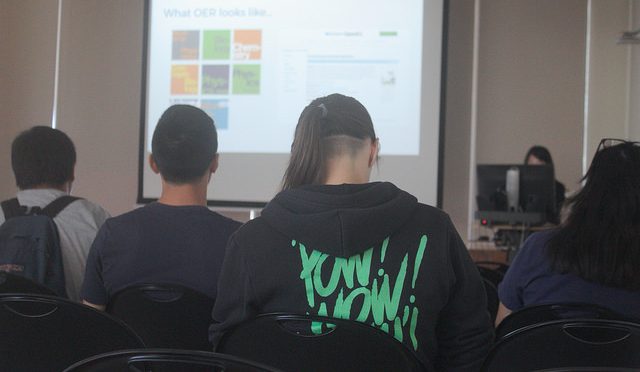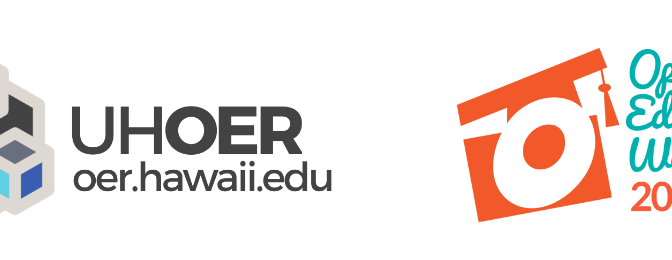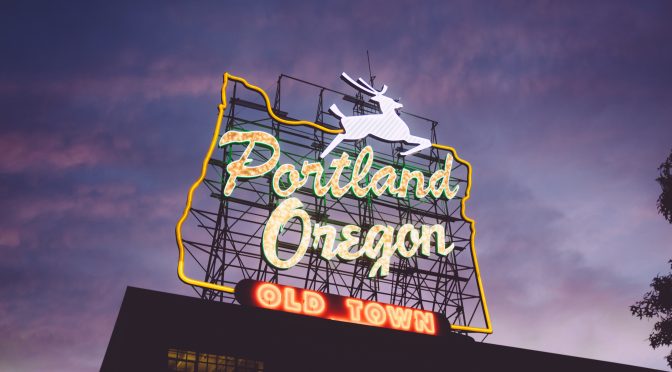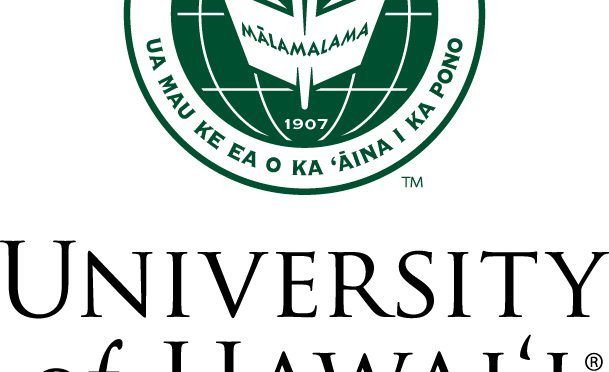This is a reblogged essay by Dr. Rajiv Jhangiani of Kwantlen Polytechnic University in Vancouver, BC.
The original post can be found on his blog (shared under a CC BY-NC 4.0 license): http://thatpsychprof.com/pragmatism-vs-idealism-and-the-identity-crisis-of-oer-advocacy/
I have shared his post here because I feel it is one of the most concise descriptions of paradoxes being revealed in the OER movement. As the movement matures, it’s important to examine the tensions that would delay our progress working towards free, open, and equitable educational resources and practices for everyone.
Enjoy.
In a couple of weeks I will be in Cape Town, presenting at the 2017 OE Global Conference. This long-ish blog post is a preview of some of the ideas I will discuss during my talk (which shares the title of this blog post). I welcome your comments as I continue to refine my ideas.
The open education movement has made and continues to make great strides, with the creation, adaptation, and adoption of OER slowly but surely becoming mainstream practice. However, as the adolescent OE movement enters a growth spurt that may see its use as primary courseware triple within five years, some noticeable paradoxes have emerged that hint at an identity crisis within the OE movement and, in particular, within OER advocacy.
Free vs. Freedom
Open education advocates customarily define OER as “beyond free,” based on the permissions to reuse, revise, remix, retain, and redistribute these resources. However, in practice, OER advocacy often centres on the unaffordability of commercial textbooks and the cost savings associated with the adoption of open textbooks (i.e. merely “free”). On the one hand, this appears appropriate, even pragmatic, given the significance of the burden of student loan debt in North America and the impact of escalating textbook costs on students’ educational choices and outcomes. Moreover, textbooks are a familiar entity to academics, and, unlike with tuition fees and costs of living, faculty control adoption decisions and consequently the cost of required course materials. At the same time, this narrow focus on cost savings is immediately less relevant in countries where faculty are less reliant on expensive textbooks. In fact, it may not even be pragmatic in North America, as recent research shows that the cost of resources is the least-considered factor for U.S. faculty when assigning required course materials. Moreover, although a cost-savings framing appeals most directly to student groups, as pointed out it is faculty who control adoption decisions. Finally, framing OER in terms of zero cost (one among many implications of open licensing) may unintentionally constrain the use of the permissions that come along with OER and disengage faculty from the opportunity to move away from bending their courses onto the structure of a textbook. Indeed, faculty who reuse, redistribute, and retain OER (themselves a minority) continue to greatly outnumber those who revise and remix OER, a pattern that may be perpetuated through the best of intentions of OER advocates. As Weller and his colleagues put it:
if cost savings were the only goal, then OERs are not the only answer. Materials could be made free, or subsidized, which are not openly licensed. The intention behind the OER approach is that it has other benefits also, in that educators adapt their material, and it is also an efficient way to achieve the goal of cost savings, because others will adapt the material with the intention of improving its quality, relevance or currency. (pp. 84-85)
Evolution vs. Revolution
OER advocates often highlight the advantages of the internet and digital technologies, especially as they enable the marginal cost of reproduction and distribution of educational resources to approach zero. However, the OER movement itself continues to grapple with questions from a pre-digital past, such as the responsibility of updated editions of open textbooks and the development of ancillary materials such as question banks. Although OER funders may (rightly) consider these matters stumbling blocks which, if not addressed, would inhibit uptake, employing the language of the commercial textbook industry runs the risk of dragging along a traditional mindset based on the top-down delivery of static and (falsely) scarce information. This begs a broader question: If open educational practices are a game changer, why are OER advocates playing by the rules of the commercial textbook industry?
Framing OER as free, digital versions of expensive print textbooks also risks playing directly into the hands of commercial textbook publishers who are in the midst of a pivot away from a business model based on selling “new editions” of print textbooks every three years to one based on leasing 180-day access to digital content delivery platforms. As post-secondary administrators begin to more seriously consider the social and fiscal consequences of high textbook costs, it will be tempting for them to capitulate to aggressive sales pitches from publishing coalitions that exchange faculty choice and student agency for slightly discounted digital textbooks. In order to avoid the most effective arguments of OER advocates being further co-opted by commercial publishers (e.g., see this product brochure from Pearson Education for their digital platform that cites data on the impact of OER adoption on student outcomes) and especially to realize the full potential of OER, the goal posts must be placed further than simply cheaper textbooks. As Robin DeRosa, an open educator who clearly favours revolution over evolution, puts it, “Fundamentally, I don’t want to be part of a movement that is focused on replacing static, over-priced textbooks with static, free textbooks.”
Resources vs. Practices
The tensions between cost savings and textbooks on the one hand and the affordances of open licenses and digital technologies on the other are manifested by contrasting emphases on OER vs. open educational practices (OEP). The latter is a broader, superordinate category that encompasses the adoption of OER and even open course design and development, but which places pedagogy (and therefore students) at its core. OEP most often manifests in the form of course assignments in which students update or adapt OER (e.g., with local examples or statistics), create OER (e.g., instructional videos or even test questions), or otherwise perform scaffolded public scholarship (e.g., writing op-ed pieces or annotating readings on the open web). Crucially, adopting OEP requires more of a shift of mindset than does adopting OER, more critical reflection about the roles of the instructor and the student when education continues to be based on content consumption rather than critical digital literacy despite information (and misinformation) being abundant. As David Wiley writes in his blog (albeit with the byline “pragmatism over zeal”), “when faculty ask themselves ‘what else can I do because of these permissions?’, we’ve come within striking distance of realizing the full power of open.”
Happily, advocating for OEP avoids the problem of inadvertently striking a judgmental tone when describing non-OER users (who may have excellent reasons supporting their choice) because discussions about innovation are not driven by guilt or avoidance. Rather, OEP articulates a vision of education that is aspirational and driven by an approach motivation. Within this broader vision, significant cost savings to students are the least significant benefit of OER.
Idealism vs. Pragmatism
The psychologist Erik Erikson articulated an eight-stage theory of psychosocial development that centered on an adolescent crisis between identity and role confusion (1956). During this stage, which persists through the college years, the adolescent begins to struggle with questions about who they really are and what they hope to achieve.
Although Erikson developed his theory to better understand lifespan development within individuals and not social movements, it is difficult to ignore the parallels between the tensions of an adolescent OE movement and the adolescent identity crisis that he described. Specifically, I believe that the frictions described above between “merely free” and “beyond free,” resources and practices, and evolution and revolution are each symptomatic of a psychosocial crisis within the OE movement that pits pragmatism against idealism.
Although OER advocates may understand and even experience both impulses, their goals and strategies often reflect one or the other. For example, whereas idealists push for for radical change that questions the status quo, pragmatists seek to build incrementally on the status quo. Whereas idealists work through collaborative networks such as faculty learning communities, pragmatists work to create grant programs for individual faculty to create, adapt, or adopt OER.And whereas idealists emphasize student-centered, personalized solutions that foreground process and agency, pragmatists emphasize instructor-centered turnkey solutions that foreground content and efficiency.
Outlined like this, it is easy to recognize the merits of both strategies. Indeed, idealists would do well to recognize that open textbook adoption tangiblybenefits students in material and educational terms that are not insignificant. On the other hand, pragmatists might recognize that the idealistic approach is appealing to those for whom the construct of a traditional textbook is a dinosaur best served by a meteor strike (and can therefore can be pragmatic).
An Integrative Solution to the Crisis
Given that Erikson believed that the individual could not be understood in terms that were separate from his or her social context (1959), I believe the key to resolving this crisis lies with an integrated approach that is sensitive to the diversity across and within the audiences whom we seek to serve.
As I have written elsewhere:
For faculty who enjoy experimenting and innovating, open textbook adoption does feel like a meagre position to advocate. These are instructors who care deeply about authentic and open pedagogy, who may take full advantage of the permissions to revise and remix, and who understand that adopting OEP is really just about good pedagogy and in that sense is not at all radical.
On the other hand,
there are faculty who currently adopt high-priced, static textbooks but care enough about their students to feel guilty about this decision (principled agents in a principal-agent dilemma). In at least some of these cases, the ensuing guilt leads them to bend the course to map onto the textbook, which, while not an example of great pedagogy, could be construed as an empathic response that ameliorates both their guilt and their students’ resentment. This is . . . where the social justice case for open textbooks may resonate particularly well.
According to Weller and his colleagues, there are three categories of OER users:
1) The OER active are
engaged with issues around open education, are aware of open licenses, and are often advocates for OERs . . . An example of this type of user might be the community college teacher who adopts an openly licensed textbook, adapts it and contributes to open textbooks. (pp. 80-81)
2) OER as facilitator
may have some awareness of OER, or open licenses, but they have a pragmatic approach toward them. OERs are of secondary interest to their primary task, which is usually teaching . . . Their interest is in innovation in their own area, and therefore OERs are only of interest to the extent that they facilitate innovation or efficiency in this. An example would be a teacher who uses Khan Academy, TED talks and some OER in their teaching. (p. 82)
3) Finally, OER consumers
will use OER amongst a mix of other media and often not differentiate between them. Awareness of licences is low and not a priority. OERs are a “nice to have” option but not essential, and users are often largely consuming rather than creating and sharing. An example might be students studying at university who use iTunes U materials to supplement their taught material. For this type of user, the main features of OERs are their free use, reliability and quality. (p. 85)
This taxonomy serves as a useful guide to OER advocates seeking to diversify or tailor their outreach strategy. For instance, OER consumers may be most interested in open textbooks and related ancillary resources that can be deployed with little or no effort. For this group, unfettered access for their students is highly desirable, with cost savings a nice bonus. On the other hand, the OER active group will be more sensitive to the impact of cost savings while also keen to learn more about the permissions to revise and remix OER. Finally, those in the OER as facilitator group will be excited by the potential to involve students in the creation or adaptation of OER via renewable assignments. Of course, this is far from an exhaustive list of strategic possibilities and only aims to illustrate the mechanics of an integrative approach.
Despite its merits, it would be naïve to believe that adopting an integrative approach would eradicate all tension within the OE movement. Idealists may continue to insist on the application of CC licenses that meet the definition of “free cultural works.” Pragmatists, on the other hand, will acknowledge that OER creators may have reasonable grounds for including a Noncommercial (NC) or even a NoDerivatives (ND) clause, even though an Attribution-only license (CC-BY) facilitates the maximum impact of OER. Pragmatists may also want to first ensure basic access for all whereas idealists may think it arrogant to insist that students first need access to required resources before partnering in pedagogical innovation. But while these tensions will not disappear, I believe it essential that we recognize both drives and have a deliberate, nuanced conversation about how best to harness both idealism and pragmatism in service of the goals of the OE movement.
So What’s Next?
In Erikson’s lifespan theory, the stages that follow adolescence pit intimacy against isolation (young adulthood), generativity against stagnation (middle adulthood), and, finally, integrity against despair (later adulthood). If these at all suggest a trajectory for the OE movement beyond its current adolescence, its advocates should aim for the next phase to involve a lot more collaboration among faculty and students, both across institutions and cohorts. This shift will require tools that support radically transparent collaboration (e.g., see the Rebus Community for Open Textbook Creation) but especially a break from traditional (opaque, territorial, top-down) approaches to curriculum design and development. As the proverb says, “if you want to go quickly, go alone. If you want to go far, go together.”
Greater collaboration and a true democratization of the process of OER development will in turn engender a move away from philanthropic, government, and other unsustainable funding models in favour of a grassroots-based, community-driven, self-sustaining approach that resembles a bazaar in its connectivity and generativity far more than it does a cathedral.
Achieving this, while neither easy nor assured, is a necessary step for the OE movement on its path to becoming more critical, more self-aware, and more inclusive of a diversity of voices. In other words, a movement characterized by integrity, not despair.
You can follow Rajiv on Twitter at https://twitter.com/thatpsychprof and see his blog at http://thatpsychprof.com/.











